Do Candidates Find Your Employer Brand Attractive?
NACVA Member Survey Findings on Employee Recruitment and Retention
Hinge Marketing recently completed a NACVA member survey. In this survey, Dr. Frederiksen learned that NACVA members sought to improve recruiting and retention in their firms. These were the two highest. In addition, gathering insights about how firms approach these challenges, we also asked employee-candidates how they search for and evaluate potential career opportunities. In this article, Dr. Frederiksen provides seven branding tips for aspiring experts.
 In our most recent survey of NACVA members, we learned that improving recruiting and retention were two of the highest priorities for firms. In addition to gathering insights about how firms approach these challenges, we also asked employee-candidates how they search for and evaluate potential career opportunities.
In our most recent survey of NACVA members, we learned that improving recruiting and retention were two of the highest priorities for firms. In addition to gathering insights about how firms approach these challenges, we also asked employee-candidates how they search for and evaluate potential career opportunities.
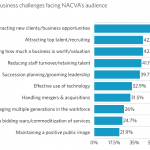 We prepared a brief report on the survey results, which NACVA is distributing to members. Here are highlights of a few key findings that could help your firm fine-tune its employer brand—that is, your reputation as a place to work—and how you communicate it to prospective candidates.
We prepared a brief report on the survey results, which NACVA is distributing to members. Here are highlights of a few key findings that could help your firm fine-tune its employer brand—that is, your reputation as a place to work—and how you communicate it to prospective candidates.
Our survey began by looking at firms’ chief business challenges. Topping the list was attracting new clients; but more interesting was the number of other challenges cited that involved acquiring, managing, and retaining talent. As shown in Figure 1, three of the top five challenges had to do with recruiting and talent retention:
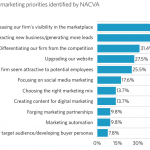 Attracting top talent/recruiting
Attracting top talent/recruiting- Reducing staff turnover/retaining talent
- Succession planning/grooming leadership
In addition, two other top-10 challenges also related to employer branding:
- Managing multiple generations in the workforce
- Maintaining a positive public image
We also asked about firms’ marketing priorities, and the results are shown in Figure 2. One might assume that these would track closely with the firms’ business challenges—and indeed, the first three marketing priorities do focus on winning business. But surprisingly, only about one-quarter of firms 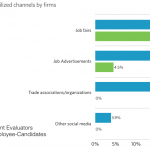 considered making their firms attractive to potential employees as a top marketing priority. One conclusion from this finding is that many firms may not fully appreciate how important marketing is to be able to attract and retain top talent.
considered making their firms attractive to potential employees as a top marketing priority. One conclusion from this finding is that many firms may not fully appreciate how important marketing is to be able to attract and retain top talent.
In addition, we sought to understand the effectiveness of various channels or resources that firms use to reach prospective employees. We asked talent-evaluators which channels they use, and also asked employee-candidates which ones they prefer to use when searching for career opportunities. The two sets of data did not always line up—and Figure 3 shows several channels that talent-evaluators tend to use more heavily than do candidates.
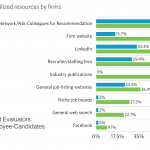 On the other hand, there were several channels that employee-candidates were more likely to use than talent-evaluators. As shown in Figure 4, employee-candidates seem to prefer using four resources in particular. Networking with colleagues was the most popular resource, and nearly two-thirds (64%) prefer reviewing a firm’s website. But only 16% of talent-evaluators’ firms had dedicated sections of their websites for recruiting. It is also worth noting that employee-candidates were just as likely to use a firm’s LinkedIn presence as a job-seeking resource as they were its website.
On the other hand, there were several channels that employee-candidates were more likely to use than talent-evaluators. As shown in Figure 4, employee-candidates seem to prefer using four resources in particular. Networking with colleagues was the most popular resource, and nearly two-thirds (64%) prefer reviewing a firm’s website. But only 16% of talent-evaluators’ firms had dedicated sections of their websites for recruiting. It is also worth noting that employee-candidates were just as likely to use a firm’s LinkedIn presence as a job-seeking resource as they were its website.
There is another area where talent-evaluators and prospective employees see things quite differently. We asked employee-candidates which types of criteria they use to evaluate career opportunities, and also asked talent-evaluators which factors they believe prospective employees find most important. 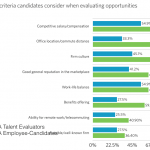 The responses are shown in Figure 5.
The responses are shown in Figure 5.
Comparing the two groups’ responses reveals that talent-evaluators may not have an accurate view of the factors employee-candidates use when considering a firm. The two most important criteria were competitive salary/compensation and office location/commute, with firm culture coming in a close third. In most cases, there was a wide discrepancy between what employee-candidates valued most highly, and what talent-evaluators thought they did. This gap was the widest when it came to:
- Office location/commute distance
- Competitive salary/compensation
- Benefits offering
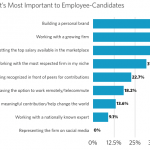 Finally, we asked candidates what they cared most about when evaluating career opportunities. We presented several different scenarios, and asked the candidates to rate each on a scale from 0–10 in terms of its importance when evaluating a firm as a potential place to work. Figure 6 shows the percentages of respondents who gave a strong endorsement (a rating of 9 or 10) for each scenario.
Finally, we asked candidates what they cared most about when evaluating career opportunities. We presented several different scenarios, and asked the candidates to rate each on a scale from 0–10 in terms of its importance when evaluating a firm as a potential place to work. Figure 6 shows the percentages of respondents who gave a strong endorsement (a rating of 9 or 10) for each scenario.
It may be surprising to know that candidates said that building their own personal brand and working with a growing firm were more important than getting the top salary in their market. Almost as important was the prospect of working with the most respected firm in their niche.
The Big Takeaways
There are many ways to use this data, but here are three insights I see as fundamental:
- Use the communication channels job candidates prefer (put less emphasis on job fairs, and more on LinkedIn, for example)
- Convey the strong points of your firm that candidates find most appealing (including location, salary, and benefits)
- Dedicate some of your marketing resources to communicating your employer brand (it works!)
Your firm’s employer brand can both attract prospective candidates and help retain current employees. But the devil is in the details—so it pays to understand what your employer brand is, and how it aligns with the needs and preferences of current and prospective employees.
Lee W. Frederiksen, PhD, is Managing Partner at Hinge, the leading branding and marketing firm for the professional services. Hinge conducts groundbreaking research into high-growth firms and offers a complete suite of services for firms that want to become more visible and grow.
Dr. Frederiksen can be contacted at (703) 391-8870 or by e-mail to LFrederiksen@hingemarketing.com.









